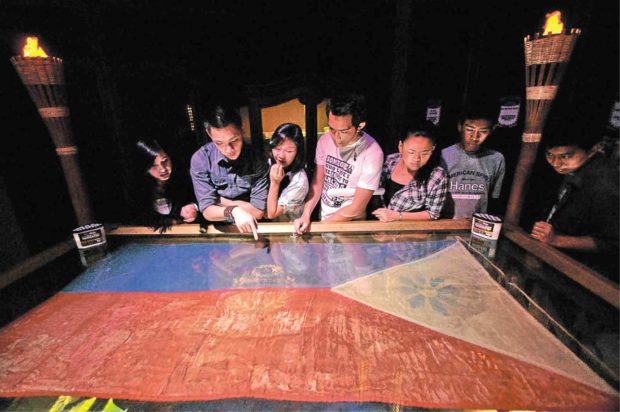
What is possibly the first Philippine flag is housed at the General Emilio Aguinaldo Museum in Baguio.—PDI ARCHIVES
It has been 120 years since the Philippine flag was waved with such pride on the front window of a mansion in Kawit, Cavite.
But recollections of significant turning points in Philippine history such as this remain vivid as these have been immortalized not only on history books, but more importantly through preserved artifacts, structures and other tangible pieces of history that survived the century.
Here, we take a look at the historical structures and places housing these relics—silent witnesses to the events that unfolded leading to the declaration of Philippine independence, and which now serve as significant reminders of our glorious past.
AGUINALDO SHRINE
Brgy. Kaingen, Kawit, Cavite
The Aguinaldo Shrine is one of the iconic spots in Cavite. It houses so much history and holds many surprises for its visitors.—PDI ARCHIVES
All roads lead to Kawit at this time of year as everyone wants a glimpse of the place where Philippine independence was proclaimed.
On June 12, 1898, the Aguinaldo Shrine was where the Philippine flag was waved from and the Act of Proclamation of the Independence of the Filipino People was read to the public by Ambrosio Bautista, its author.
The Aguinaldo Shrine was where Gen. Emilio Aguinaldo lived until his death in 1964. The mansion was designed by Aguinaldo himself and was constructed in 1845. It started as a simple nipa and wood structure before undergoing reconstruction four years later using a variety of Philippine hardwood.
It has a floor area of over 1,300 sqm and is divided into three areas—the main house, a lookout tower and the family wing—on a 4,864 sqm lot. It has seven levels, counting the mezzanine and turret.
The Philippine flag was waved from a front window and not a balcony. The mansion’s balcony was a late addition, being built in 1919. The house’s tower along with intricate details such as nationalistic themes, masonic symbols and Art Nouveau decorations was added by the 1920s.
The Aguinaldo mansion holds surprises for its visitors with its bowling alley, secret passageways, concealed doors and hiding places for documents and weapons. It has a bomb shelter which can be accessed from the dining area on the second floor and can help one escape to the nearby church or cemetery by going through a tunnel.
Aguinaldo Shrine operating hours: Tuesday to Sunday, 8 a.m. to 4 p.m.
EMILIO AGUINALDO MUSEUM
Gen. Luna Road, Baguio
Owned by the Emilio Aguinaldo Foundation, the Emilio Aguinaldo Museum houses possibly the first and oldest surviving flag of Philippine independence.
The flag is encased in glass and can be viewed in a dimly-lit room, the temperature of which is kept at 25 degrees Celsius. The temperature-controlled room is necessary to keep the flag from further deteriorating.
The museum was put up by the heirs of the late Cristina Aguinaldo-Suntay, Aguinaldo’s daughter. It was said that the flag was found tucked in the late president’s death bed. According to the family, it was the same flag that Marcela Agoncillo had sewn in Hong Kong and which was waved in Kawit on June 12, 1898.
Emilio Aguinaldo Museum hours: Tuesday to Sunday, 10 a.m. to 5 p.m.
PRESIDENTIAL MUSEUM AND LIBRARY
Malacañang Palace, Manila
Located in Kalayaan Hall and formerly known as Malacañang Museum, the Presidential Museum and Library houses the memorabilia of Philippine presidents.
The building has a neo-Renaissance style designed by American architect Ralph Harrington Doane. Here, you can see the thimble used by Marcela Agoncillo when she painstakingly sewed the Philippine flag under the request of Gen. Aguinaldo.
The Presidential Museum and Library is open Mondays through Fridays from 8 a.m. to 5 p.m.
MORRISON HILL
Hong Kong
When he was exile in Hong Kong, Gen. Aguinaldo asked Marcela Agoncillo to hand-sew a flag designed by himself which would represent the national aspirations of the Filipinos. During this time, Agoncillo was also living in exile with her family at 535 Morrison Hill. Their house also doubled as a refuge for other Filipino revolutionaries. Hong Kong’s Antiquities and Monuments Office installed a marker at the site where Agoncillo’s residence used to be. It is now part of the Morrison Hill Road Playground.
Sources: PDI Archives, National Historical Commission of the Philippines